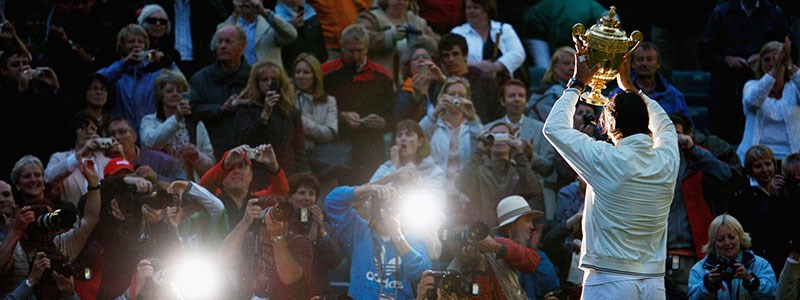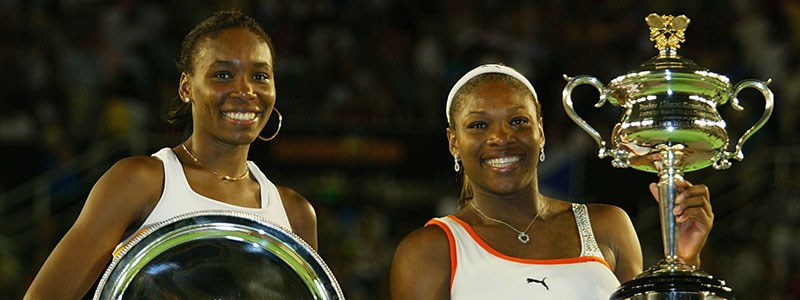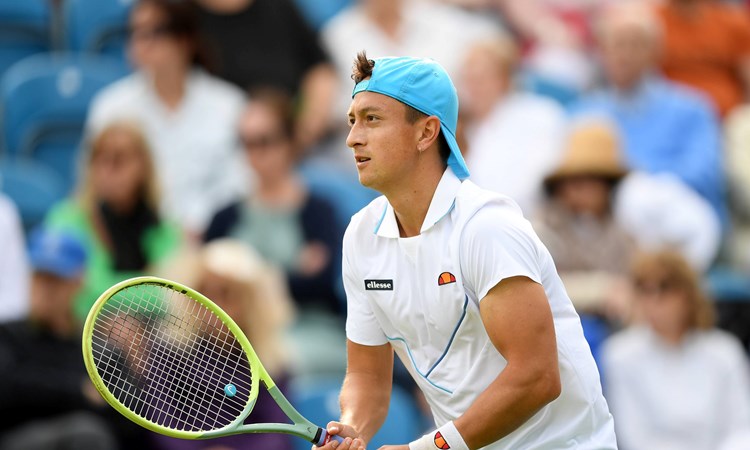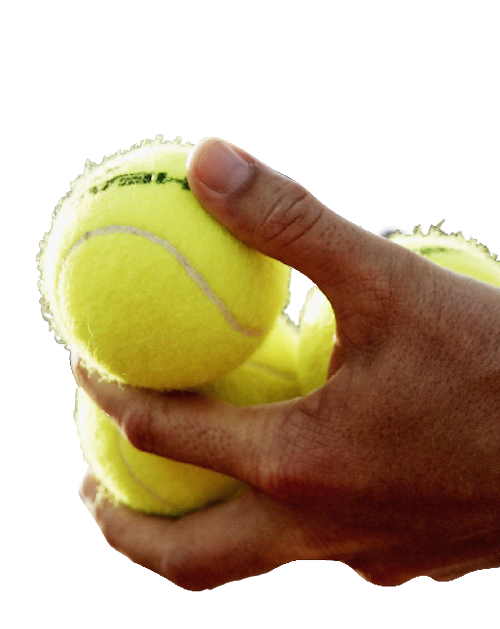Open Era 2000-2009: The big names begin their hunt for trophies
• 8 MINUTE READ
Some of the biggest stars in today’s tennis galaxy were already winning titles in the early 2000s. Joining their number was a talent the likes of which Britain had not seen in generations – a certain Andy Murray. By Alex Sharp
Catch a Rafael Nadal forehand in slow motion and you’ll see the crowd gasping in amazement, beads of sweat rolling down the Spaniard’s bandana, his bicep bulging as it lassoes around his head, yet somehow the ball is spinning as if it’s in real time.
Synthetic strings and ever evolving racket technology gave players the weapons to catapult the ball across the net at devastating speed. In order to harness such velocity, players have been forced to add sufficient topspin to keep the ball in play.
The first ever men’s Open Era Grand Slam champion Ken Rosewall, using a wooden racket with gut strings, managed to impart spin in the region of 1500 rotations-per-minute on the ball.
Fast forward almost 30 years and Nadal, the ‘King of Clay’, who shot to prominence with spectacular loop on his shots, hit the scene with an average of 3700rpm and a maximum of 4900rpm. That’s a lot of spin!

The force, the athleticism required to reach the top, the technology, all contributed to a ferocious, gladiatorial physicality to the sport at the turn of the century.
On the men’s side, prototype power players Marat Safin and Andy Roddick, along with the ultimate counterpuncher Lleyton Hewitt, threatened to dominate the 2000s.
However, these exemplary forces were coming to the fore just at the wrong time. A Swiss maestro with a distinctive pony tail was about to rip up the record books. Roger Federer was on the scene.
His 2003 Wimbledon triumph over Mark Philippoussis signalled the start of an imposing period of dominance.
A 74-6 record in 2004 was edged 81-4 in 2005, before the outstanding 92-5 on 2006. During that campaign, the Swiss reached the final in 16 of the 17 tournaments he entered.

In 2004, 2006, and 2007 he won three majors a season, collecting 15 in total in the decade.
Complimenting the statistics was the style in which he sauntered to victory. Federer made brutal forehands, cutting slices, last-ditch volleys, and pin-point serving look effortless. He rarely looked out of position or flustered. He glided and skipped across the confines of the court, a ballerina wielding a Wilson racket.
During this spell, a piece of kit called Hawkeye sprung onto the scene.
The 2006 pre-season Hopman Cup in Perth, Western Australia, was the first elite-level tournament where players could challenge point-ending calls.
The 10 cameras focusing on the moving ball enabled dubious calls, or incorrect player perceptions, to be cleared up and the US Open led the change as the first Grand Slam event to use the system.

By this point Rafael Nadal had already swatted away Federer on clay to rule Roland Garros. However, in 2008 their burgeoning rivalry hit a crescendo on Federer’s Wimbledon territory.
Sublime shot-making from the five-time defending champion saved match points in the enthralling fourth set tiebreak, but Nadal eventually inflicted a 6-4, 6-4 6-7(5), 6-7(8), 9-7 defeat with the camera flash bulbs bursting through the darkness looming over Centre Court. It was a full-throttle thriller and proved Nadal could flourish on any surface.
The Wimbledon title was back in Federer’s clutches 12 months later, having pipped a pulsating 16-14 decider with Roddick at SW19.
The Federer-Nadal monopoly was rarely broken. Safin reached the pinnacle of his play to outfox Federer at his peak in the awesome 2005 Australian Open semi-final. A steely Serbian Novak Djokovic blazed to glory at Melbourne Park in 2008 and in 2009, the sledgehammer shots of Juan Martin Del Potro ended the Swiss’ five-year reign in New York.
Similarly, world No.25 Robin Soderling pulverised the ball to inflict a maiden loss on Nadal’s cherished Parisian red clay in the 2009 French Open fourth round, which intriguingly opened the path for Federer to complete his career Grand Slam.

Right until Federer’s true dominance kicked in, Tim Henman was still notching up Grand Slam semi-final showings. Who could forget the rain-delayed duel with Goran Ivanisevic, which ultimately ended in 2001 heartache out on the Hill?
Amid these classic encounters a wiry Scot was soaring into the spotlight.
18-year-old Andy Murray had former Australian Open champion Thomas Johansson on the ropes at The Queen’s Club in 2005, but cramp and a twisted ankle halted his progress.
That was the taster before the teenager – ranked world No.312 – took up a Wimbledon wildcard, falling in a turbulent five-setter against 2002-finalist David Nalbandian in the third round.
There was no looking back for Murray. Incrementally, he built up his frame with a relentless work ethic to take down Stan Wawrinka, Del Potro, and Nadal for a maiden Major final in 2008 in New York. Federer took home the honours that night, but the foundations for Murray to enter the ‘Big Four’ were well and truly set.

Jamie was the first Murray sibling to taste Grand Slam success. With his wild mane of hair, the Scot partnered Jelena Jankovic to mixed doubles glory in 2007 over Jonas Bjorkman and Alicia Molik on the lawns at the All England Club.
The ramped-up evolution of power and athleticism could also be seen on the WTA tour. Look no further than the Williams sisters from Compton, California.
Serena and Venus raised the bar in 21st century tennis with their relentless dedication and drive. Pinning back opponents with laser-like serves, they were strong off both wings, and demonstrated their doubles prowess at the net.
The sisters met 18 times in the decade (11-7 to Serena), with 17 Grand Slams singles trophies won between them (10-7 Serena). Counting the 2002 French Open until the 2003 Australian Open, Serena prevailed over Venus in all four major finals to land the ‘Serena Slam’.
Role models on and off the court, the Williams sisters were outspoken regarding equality in the sport.

“For the record, the Ladies’ final at Wimbledon in 2005 [when was Venus embroiled in an absorbing clash with Lindsay Davenport] lasted 45 minutes longer than the men’s. No extra charge,” quipped Venus in 2006 at critics of equal prize money.
A quick flashback: the US Open was the first major to offer equal pay for men and women back in 1973. Years of persistence and talk finally culminated with Wimbledon completing the Grand Slam set in 2007.
A shock came for Serena in 2004, when a towering Russian teenager named Maria Sharapova upset the defending champion on the grass at Wimbledon to win her opening Grand Slam.
The diminutive Justin Henin lifted seven Slams in the decade, a remarkable feat considering the calibre and dominance of the Williams sisters.
The Belgian’s flowing game had one standout weapon, a wound-up single-handed backhand that proved, alongside Federer’s, specific artistry was still able to thrive in the modern era of force.

The 2000s had plenty of heart-warming moments upon which to reflect.
Gustavo Kuerten (Guga to his legion of fans) was an amicable world No.1 and cemented himself in Roland Garros royalty in 2001 with a third French Open title.
With his beaming grin, the Brazilian used his racket to draw a huge love heart onto the red dirt and then lay in it to lap up the applause having beaten Alex Corretja. What a celebration.
Kim Clijsters certainly held the crown for comeback of the decade.
The Belgian had left the Tour for motherhood but returned to the big time at the 2009 US Open, having not played a major in two years and not in New York since 2005.

An inspired Clijsters fended off Caroline Wozniacki 7-5, 6-3 to prompt one-year-old daughter Jada to waddle onto the court to greet her elated mother with the trophy.
A key shift in the fashion stakes were player logos.
Federer’s ‘RF’ was incorporated into his kit having started using the branding in 2008, including a brave gold-trimmed cardigan at Wimbledon. It also coupled as branding for his foundation.
The number of players with brand endorsements and their own logos surged in the 2000s, for example Wozniacki stepped out in Stella McCartney’s lines for Adidas.
Stars such as Sharapova and Venus designed their own looks, we saw Swarovski crystals glimmer on court, outlandish outfits like lace dresses or sparkling cat suits.
Outfits in the 2000s were certainly experimental.





